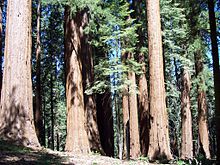Leopold Report
Named for its chairman and principal author, zoologist and conservationist A. Starker Leopold, the report proved influential for future preservation mandates.
Species such as elk and antelope were considered a major attraction for park visitors, and an attempt was made to increase their numbers through winter feeding and predator control.
The International Association of Game and Fish Commissioners protested the "slaughtering of elk by hired killers" rather than by sportsmen, and schoolchildren from across the country were inspired to write letters of condemnation.
[6] The controversy surrounding the reduction of elk in Yellowstone shed a negative light upon the NPS and their management of wildlife populations within the country's national parks.
[13] The report also supported the concept of carrying capacity, and the idea that the elk population could be actively managed to restore its natural balance.
Recreational hunting was strongly opposed, but the report allowed for select members of the public to assist in the "sole purpose of animal removal".
[15] The main goal of the NPS, the report explained, was to preserve national parks primarily for the "aesthetic, spiritual, scientific and educational values they offered to the public".
[14] The report strayed from arguments based on scientific data and veered into environmental philosophy, concluding that national parks should serve a historical purpose.
The wolf and grizzly bear cannot readily be reintroduced into ranching communities, and the factor of human use of the parks is subject only to regulation, not elimination.
Acknowledging the harm caused to nature by humans, the advisory board asked for the implementation of "a set of ecologic skills unknown in this country today".
A call to arms was raised for exploring new methods of active protection and restoration of plant and animal life in the national parks: "Americans have shown a great capacity for degrading and fragmenting native biotas.
[17] Conrad L. Wirth, director of the NPS from 1951 to 1964, stated that the report reworded the Service's 1916 mandate into "modern language", using a scientific perspective to redefine the basic purpose of national parks.
[21] The memorable idea of a "vignette of primitive America" drew popular attention from readers[22] and the report received widespread publicity and praise amongst conservationists.
[16] This underbrush would have been naturally eradicated by lightning storms, but because of policies that supported wildfire suppression, the growth threatened the park's Giant Sequoia trees.
[31] As a result of the Cain Report's recommendations, President Richard Nixon signed Executive Order 11643, which restricted the usage of poisons such as strychnine and sodium cyanide for predator control.
Author of the book Searching for Yellowstone: Ecology and Wonder in the Last Wilderness, Paul Schullery, wrote of the report: "Scholars return to it for new interpretations and even inspiration regularly, speakers invoke it on all occasions, and it is trotted out to prove almost every perspective in debates about modern park management.
"[3] On the other hand, Alston Chase, a vocal critic of the National Park Service, disapproved of the limited scope of the Leopold Report, arguing that it had "inadvertently replaced science with nostalgia, subverting the goal it had set out to support".



